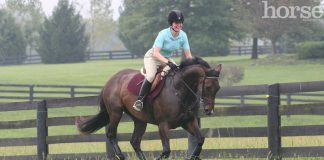One of the easiest ways to track your training progress is to feel your horse’s body all over while you’re tacking him up every day. This physical check-in allows you to detect how he is responding to your program, whether he is becoming stronger in the right places and ways. Simple but effective, this hand-touch often tells you more about your horse than your riding exercises.
For instance, many riders enthusiastically watch their horse’s topline change as they tackle dressage maneuvers on a consistent basis. They mistakenly assume that the enlarged muscling along the horse’s spine indicates a stronger back, and therefore their training must be going great. Touching these muscles, though, is often like pressing against a rock. Underneath the saddle, the horse’s back is rigid and hard. When this is the case, the horse cannot optimally swing through his back with the movement generated by his hindquarters. He must take choppy, restricted strides as this tension spread down to his Lattisimus muscle attached to his shoulder blades. His back will be uncomfortable during work, affecting his ability to canter well, respond to the rider’s seat, and bend. Muscles become rock-like when they lack sufficient oxygen and blood flow, thereby losing their pliability and nutrition.
Muscles often develop unfavorably like this for a number of reasons—hoof imbalances, living conditions (stall confinement), incorrect training programs, and problems with tack or rider balance. Monitoring the feel of his muscles day by day allows riders to track what changes in his routine might not be agreeing positively with him. This way, they can eliminate them before his body condition becomes rigidly irreversible. Has he been performing the same sorts of exercises? Is he in a poor fitting saddle? Has his workload increased or decreased?
There is no precise way to survey your horse’s body. Develop a routine that works for you; just be sure to perform it consistently. I generally run my hands along my horse’s neck, topline, and hamstrings as I brush him to ride. I make mental notes about any changes in the feel under my hands, especially when I have increased a horse’s workload or changed something in his routine (new saddle, different riders, change in weather). There is so much your horse’s body can tell you, and you certainly do not need to rely on a massage therapist to unlock these secrets. A simple hands-on check in daily will do the trick.
Liked this article? Here are others you’ll enjoy:
Video: Riding in Different Postures
Start Your Horse’s Spring Training
JEC ARISTOTLE BALLOU is the author of 101 Dressage Exercises for Horse & Rider.






good info.
Good information, I am also reading/studying how t give equine massages.
And in summer it’s easy to see the difference. My horses look pretty great!
Great reminder. This time of year it is easy to get excited and want to hurry and ride while the sun is up! 😉